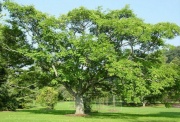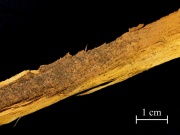Difference between revisions of "Amur cork tree"
Jump to navigation
Jump to search
m (Text replace - "\[http:\/\/cameo\.mfa\.org\/materials\/fullrecord\.asp\?name=([^\s]+)\s(.*)\]" to "$2") |
|||
| Line 2: | Line 2: | ||
== Description == | == Description == | ||
| − | The bark from the amur cork tree (''Phellodendron amurense'') is extracted to produce a yellow dye. The principal colorant is [[ | + | The bark from the amur cork tree (''Phellodendron amurense'') is extracted to produce a yellow dye. The principal colorant is [[berberine sulfate|berberine]]. |
== Synonyms and Related Terms == | == Synonyms and Related Terms == | ||
Revision as of 10:59, 30 June 2020
Description
The bark from the amur cork tree (Phellodendron amurense) is extracted to produce a yellow dye. The principal colorant is berberine.
Synonyms and Related Terms
Phellodendron amurense; kihada (Jap.); Japanese yellow wood
Other Properties
Autofluorescence = intense yellow
Additional Information
S.Shimoyama, Y.Noda, S.Katshuhara, "Non-Destructive Analysis of Ukiyo-E Prints" Dyes in History and Archaeology, No.15, Paper presented in Manchester England, Nov. 1996.
Additional Images
Sources Checked for Data in Record
- Encyclopedia Britannica, http://www.britannica.com Comment: cork tree" Encyclopædia Britannica [Accessed March 5, 2002].
- R.Feller, M.Curran, C.Bailie, 'Identification of Traditional Organic Colorants Employed in Japanese Prints and Determination of their Rates of Fading', Japanese Woodblock Prints, Allen Memorial Art Museum, Oberlin College, Oberlin, 1984




